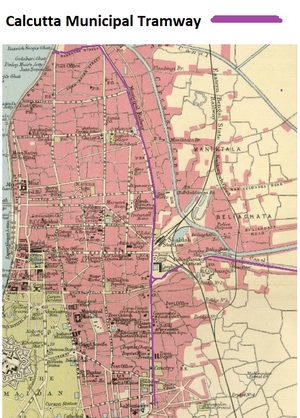Difference between revisions of "Calcutta Tramways Company"
(Complete rewrite with Links References, etc) |
(Map added) |
||
| Line 5: | Line 5: | ||
The British-Indian government started '''The Calcutta Tramways Company Limited''' in 1880 as a registered joint stock company in London. The same year a metre gauge([[Rail_gauge_#Metre_Gauge|MG]]) horse-drawn track between Sealdah and Armenian Ghat via Bowbazar Street, Dalhousie Square Customs House and Strand Road was laid <ref name=hindu/> | The British-Indian government started '''The Calcutta Tramways Company Limited''' in 1880 as a registered joint stock company in London. The same year a metre gauge([[Rail_gauge_#Metre_Gauge|MG]]) horse-drawn track between Sealdah and Armenian Ghat via Bowbazar Street, Dalhousie Square Customs House and Strand Road was laid <ref name=hindu/> | ||
| + | [[File:Calcutta Municipal Tramway.png|thumb| Calcutta Municipal Tramway]] | ||
The horse tram system opened in January 1881 and gave way to steam locomotives from 1882 <ref name=tramz>[http://www.tramz.com/tva/tvx.html "Tram Views of Asia/India/Calcutta"]; Retrieved 31 Aug 2016 </ref>. | The horse tram system opened in January 1881 and gave way to steam locomotives from 1882 <ref name=tramz>[http://www.tramz.com/tva/tvx.html "Tram Views of Asia/India/Calcutta"]; Retrieved 31 Aug 2016 </ref>. | ||
Revision as of 09:29, 6 December 2020
Calcutta Tramways
A horse tram system opened in January 1881, after a premature experiment in February 1873, a 2.4 mile(3.9 km) tramway service between Sealdah and Armenian Ghat Street was started. It wound up in November due to lack of takers [1].
The British-Indian government started The Calcutta Tramways Company Limited in 1880 as a registered joint stock company in London. The same year a metre gauge(MG) horse-drawn track between Sealdah and Armenian Ghat via Bowbazar Street, Dalhousie Square Customs House and Strand Road was laid [1]
The horse tram system opened in January 1881 and gave way to steam locomotives from 1882 [2].
By the end of the nineteenth century the company owned 166 tram cars, 1000 horses, seven steam locomotives and 19 miles (30km) of tram tracks [3].
During 1900, Electrification of the tramway, and reconstruction of tracks to 4 ft 8 1⁄2 in (1,435 mm) standard gauge (SG) commenced [3].
Electric trams began running on March 27, 1902 and by 1921 there were 35 miles (56 km) of MG track and 512 cars in service [2]
The tram system is still operating today [4].
References
- ↑ 1.0 1.1 The Hindu “Old Wheels still going strong” by Madhumitha Srinivasan, March 21, 2011"; Retrieved 31 Aug 2016
- ↑ 2.0 2.1 "Tram Views of Asia/India/Calcutta"; Retrieved 31 Aug 2016
- ↑ 3.0 3.1 Wikipedia “Trams in Kolkata"; Retrieved 31 Aug 2016
- ↑ Wikipedia "Tram transport in India/Kolkata""; Retrieved 31 Aug 2016
